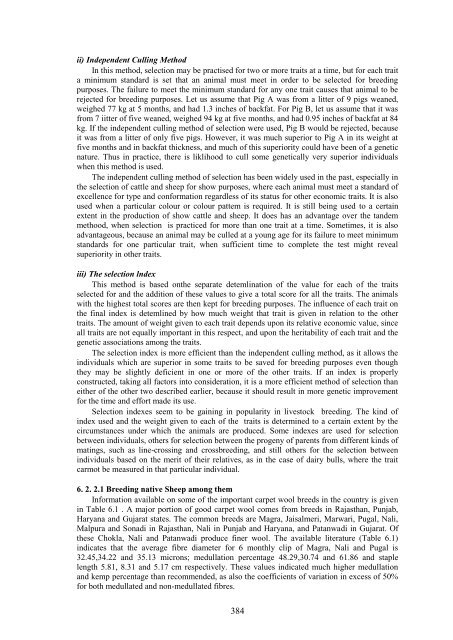Create successful ePaper yourself
Turn your PDF publications into a flip-book with our unique Google optimized e-Paper software.
ii) Independent Culling Method<br />
In this method, selection may be practised for two or more traits at a time, but for each trait<br />
a minimum standard is set that an animal must meet in order to be selected for breeding<br />
purposes. The failure to meet the minimum standard for any one trait causes that animal to be<br />
rejected for breeding purposes. Let us assume that Pig A was from a litter of 9 pigs weaned,<br />
weighed 77 kg at 5 months, and had 1.3 inches of backfat. For Pig B, let us assume that it was<br />
from 7 iitter of five weaned, weighed 94 kg at five months, and had 0.95 inches of backfat at 84<br />
kg. If the independent culling method of selection were used, Pig B would be rejected, because<br />
it was from a litter of only five pigs. However, it was much superior to Pig A in its weight at<br />
five months and in backfat thickness, and much of this superiority could have been of a genetic<br />
nature. Thus in practice, there is liklihood to cull some genetically very superior individuals<br />
when this method is used.<br />
The independent culling method of selection has been widely used in the past, especially in<br />
the selection of cattle and sheep for show purposes, where each animal must meet a standard of<br />
excellence for type and conformation regardless of its status for other economic traits. It is also<br />
used when a particular colour or colour pattem is required. It is still being used to a certain<br />
extent in the production of show cattle and sheep. It does has an advantage over the tandem<br />
methood, when selection is practiced for more than one trait at a time. Sometimes, it is also<br />
advantageous, because an animal may be culled at a young age for its failure to meet minimum<br />
standards for one particular trait, when sufficient time to complete the test might reveal<br />
superiority in other traits.<br />
iii) The selection lndex<br />
This method is based onthe separate detemlination of the value for each of the traits<br />
selected for and the addition of these values to give a total score for all the traits. The animals<br />
with the highest total scores are then kept for breeding purposes. The influence of each trait on<br />
the final index is detemlined by how much weight that trait is given in relation to the other<br />
traits. The amount of weight given to each trait depends upon its relative economic value, since<br />
all traits are not equally important in this respect, and upon the heritability of each trait and the<br />
genetic associations among the traits.<br />
The selection index is more efficient than the independent culling method, as it allows the<br />
individuals which are superior in some traits to be saved for breeding purposes even though<br />
they may be slightly deficient in one or more of the other traits. If an index is properly<br />
constructed, taking all factors into consideration, it is a more efficient method of selection than<br />
either of the other two described earlier, because it should result in more genetic improvement<br />
for the time and effort made its use.<br />
Selection indexes seem to be gaining in popularity in livestock breeding. The kind of<br />
index used and the weight given to each of the traits is determined to a certain extent by the<br />
circumstances under which the animals are produced. Some indexes are used for selection<br />
between individuals, others for selection between the progeny of parents from different kinds of<br />
matings, such as line-crossing and crossbreeding, and still others for the selection between<br />
individuals based on the merit of their relatives, as in the case of dairy bulls, where the trait<br />
carmot be measured in that particular individual.<br />
6. 2. 2.1 Breeding native <strong>Sheep</strong> among them<br />
Information available on some of the important carpet wool breeds in the country is given<br />
in Table 6.1 . A major portion of good carpet wool comes from breeds in Rajasthan, Punjab,<br />
Haryana and Gujarat states. The common breeds are Magra, Jaisalmeri, Marwari, Pugal, Nali,<br />
Malpura and Sonadi in Rajasthan, Nali in Punjab and Haryana, and Patanwadi in Gujarat. Of<br />
these Chokla, Nali and Patanwadi produce finer wool. The available literature (Table 6.1)<br />
indicates that the average fibre diameter for 6 monthly clip of Magra, Nali and Pugal is<br />
32.45,34.22 and 35.13 microns; medullation percentage 48.29,30.74 and 61.86 and staple<br />
length 5.81, 8.31 and 5.17 cm respectively. These values indicated much higher medullation<br />
and kemp percentage than recommended, as also the coefficients of variation in excess of 50%<br />
for both medullated and non-medullated fibres.<br />
384




